 |
Until our age of jet-setting musicians with multinational careers, in which long-term residence in a single country has became a stigma of limitation, much was made of the unique qualities that distinguised diverse national cultures.  Although they were geographic neighbors, an especially wide esthetic gulf divided the music of France and Germany. César Franck was one of the first composers to bridge that gap through his only symphony. Although they were geographic neighbors, an especially wide esthetic gulf divided the music of France and Germany. César Franck was one of the first composers to bridge that gap through his only symphony.
 Franck was well-placed for that role. Actually, while often credited with revitalizing French music, Franck wasn't French but Belgian. Although independent at the time of Franck's birth in 1822, Belgium had recently been under Austrian rule. His parents, too, were Germanic. Yet, he moved to France, was trained and lived there, and became a naturalized citizen. Franck was well-placed for that role. Actually, while often credited with revitalizing French music, Franck wasn't French but Belgian. Although independent at the time of Franck's birth in 1822, Belgium had recently been under Austrian rule. His parents, too, were Germanic. Yet, he moved to France, was trained and lived there, and became a naturalized citizen.
Franck's career was one of vast peaks and valleys.
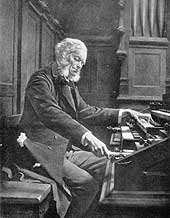
Cesar Franck at his organ
(Jeanne Rongier, 1885) |
Phenomenally talented, he won special prizes at the Paris Conservatoire not only for piano performance but for such unprecedented feats as transposing while sight-reading and combining his examinations in fugue and sonata writing into a single complex composition. But before graduation, his father withdrew him from the Conservatoire to give concerts with his violinist brother Joseph (who at first became far more famous). Franck then taught and composed sporadically with little success. After years of inactivity, he switched instruments and became the organist at the humble parish church of St. Eustache, where he seemed destined to close out a life of failed promise.
Perhaps it was the gloom of his family life – Franck was estranged from his father, and his shrewish wife detested all but the most puerile of his music – that led him to turn inward, where he found his only success as a performer and teacher. From 1858 he presided over the splendid organ in the new basilica of Ste. Clotilde and ultimately became known as the greatest organ improviser of his time. In 1872 he was appointed Professor of Organ at the Conservatoire and in 1885 he was awarded the Legion of Honor for his teaching. Yet, his creative instincts overflowed the private world of his organ manuals and pedals – he often ran afoul of the rigid academic categories imposed by the Conservatoire administration by devoting his performance courses to lectures on his beloved Bach and providing his students guidance in composition.
Franck turned earnestly to composing only in 1872, at the age of 50. Even then, he won far fewer plaudits in that field than with performing and teaching, in part due to his serene personality (although to modern eyes, it seems curiously at odds with his face, sandwiched between frighteningly bushy sideburns which he sported throughout his adult life). Philip Hale recalled: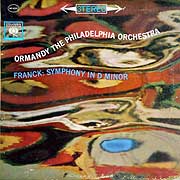 "Franck went through this life as a dreamer, seeing little or nothing of that which passed about him, thinking only of his art and living only for it. True artists are subject to this kind of hypnotism – the inveterate workers, who find the recompense of their labors in the accomplished fact, and incomparable joy in the pure and simple toil of each day." Many invoked Franck in religious terms. James Lyons calls him "a modest musical messiah, the manifest vision of music's first authentic mystic" and Robert Bager cites "a sacred trust" in which his art became a mission to which he sacrificed worldly gain and fame. Indeed, his many students worshipped him, calling him "Father Franck" out of both respect and reverence, with consequences not altogether good. "Franck went through this life as a dreamer, seeing little or nothing of that which passed about him, thinking only of his art and living only for it. True artists are subject to this kind of hypnotism – the inveterate workers, who find the recompense of their labors in the accomplished fact, and incomparable joy in the pure and simple toil of each day." Many invoked Franck in religious terms. James Lyons calls him "a modest musical messiah, the manifest vision of music's first authentic mystic" and Robert Bager cites "a sacred trust" in which his art became a mission to which he sacrificed worldly gain and fame. Indeed, his many students worshipped him, calling him "Father Franck" out of both respect and reverence, with consequences not altogether good.
Lyons notes that while Franck sat unflustered and imperturbable in the sanctuary of his organ loft, he became the unwitting eye of a hurricane that raged about him, as detractors, perhaps jealous of his students' adulation, countered the deification with far harsher barbs than he might otherwise have attracted. 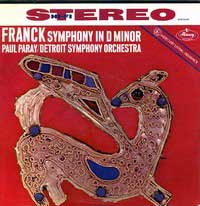 Paul Henry Lang called Franck "at once the most overrated and most calumniated of composers of recent times." Significantly, both the criticism and occasional (mostly posthumous) praise centered upon Franck transliterating his organ technique to an orchestra. Thus, detractors often attribute his doubling of parts, bass pedal-points and overloaded instrumentation to the texture of organ voices, his incessant modulation and chromaticism to customary organ compositional technique, and his meandering structures and hesitant routine sequencing to the need of an improviser to await further inspiration or to pause while changing organ stops. Indeed, even his imperviousness to feedback and unwillingness to popularize his outlook have been traced to the physical (and emotional) isolation of his organ loft. At the same time, proponents cite his expressive use of polyphony and canon, as well as his satisfying structures
(proceeding from darkness and doubt to light and certainty) to the essence of the outstanding solo improvisations for which he was famed. A hallmark of his mature art, and the primary innovation with which he is credited, is cyclical form, in which initial themes recur transformed throughout a work; Leon Vallas cites this, too, as a component of improvisation, in which repetition of thematic germs can recharge the texture. Paul Henry Lang called Franck "at once the most overrated and most calumniated of composers of recent times." Significantly, both the criticism and occasional (mostly posthumous) praise centered upon Franck transliterating his organ technique to an orchestra. Thus, detractors often attribute his doubling of parts, bass pedal-points and overloaded instrumentation to the texture of organ voices, his incessant modulation and chromaticism to customary organ compositional technique, and his meandering structures and hesitant routine sequencing to the need of an improviser to await further inspiration or to pause while changing organ stops. Indeed, even his imperviousness to feedback and unwillingness to popularize his outlook have been traced to the physical (and emotional) isolation of his organ loft. At the same time, proponents cite his expressive use of polyphony and canon, as well as his satisfying structures
(proceeding from darkness and doubt to light and certainty) to the essence of the outstanding solo improvisations for which he was famed. A hallmark of his mature art, and the primary innovation with which he is credited, is cyclical form, in which initial themes recur transformed throughout a work; Leon Vallas cites this, too, as a component of improvisation, in which repetition of thematic germs can recharge the texture.
Charles Borders contended: "Father Franck is the offspring of his pupils." Vallas claims that it was Franck's students who got him elected to head the Société Nationale, where his visibility, and thus vulnerability, was magnified, and who urged him to compose large-scale works for the concert hall. Of those, among the most popular nowadays are the Quintet in f for Piano and Strings (1879), Le chasseur maudit (The Cursed Hunter, 1882), the Symphonic Variations for Piano and Orchestra (1885), and the Sonata in A for Violin and Piano (1886).
Only the Quintet was a success, and even then just in a single performance shortly before Franck's death in 1890. The sad history of Franck performances was set with his first major work, the tone poem Rédemption (1875), which the orchestra resisted, rehearsed insufficiently and played poorly, driving most of the audience out before the end. For his most ambitious work, the sprawling 1880 oratorio Les Béatitudes, he arranged a private performance and invited all the prominent musicians of Paris, but only two showed up. (A second performance was a triumph – three years after Franck died.)
 Paramount among Franck's work is his 1886-8 Symphony in d. Typically, when asked if it was inspired by a particular idea, Franck said only: "No, it is just music, nothing but pure music." Yet it unabashedly displays all the hallmarks of his distinctive style. Paramount among Franck's work is his 1886-8 Symphony in d. Typically, when asked if it was inspired by a particular idea, Franck said only: "No, it is just music, nothing but pure music." Yet it unabashedly displays all the hallmarks of his distinctive style.

The opening motif |
The Symphony begins with the same somber, questioning motif with which Beethoven had opened the finale of his last string quartet, which he had labeled: "Must it be?" and with which Liszt had begun his Les Préludes. While the reference to these precedents is curious, and perhaps unconscious, in purely musical terms it seems an appropriate entrée to the air of mystery that infuses the first movement, which careens between the probing opening and more dynamic, forceful ideas. The main melody that emerges is not only memorable in its own right but typifies Franck's writing, as it is built on a short,

The main melody of the first movement |
repeated phrase, wraps around a single note, is contained in a small interval, and accents weak beats.
Franck next departs from convention by combining the two middle movements into one. As he noted with pride, every beat of the opening andante section equals a full bar of the following scherzo, so they superimpose nicely once each has been developed. Franck further tweaked tradition by writing a lovely plangent sinuous melody that admirably suits the character of a solo cor anglais – an alto oboe making its first appearance in a symphony.

The lovely cor anglais melody |
Incidentally, the instrument is named not for England but for the curved (anglé in French) tube that holds its reed outward so the player can hold and finger the long body more comfortably. In an unintended glimpse toward the future, Franck begins the movement with a pizzicato condensation of the primary melody, a nifty and novel nack that would become a hallmark of pop arrangements in our own time.
On to the finale. His acolyte Vincent D'Indy noted that Franck regarded the sharp keys as representing the luminous idea of redemption. Eschewing the extensive modulations of the first two movements, the last rarely strays from D major.

The joyous theme of the finale |
In John Manduell's description, it is built around "one of the most genuinely joyous and uncomplicated melodies Franck ever wrote" that builds incessantly toward a culmination of blazing glory. But first, Franck exhibits his trademark cyclical form, bringing back the cor anglais melody first in its natural state and then in a spiky permutation. Franck was quite proud of this, claiming a precedent in Beethoven's Ninth, but insisting that here the recall is not a mere quotation, but rather that it plays an entirely new role in the music. (Perhaps a closer parallel would have been the Beethoven Fifth, in which a return of the scherzo melody adds enormous structural impetus to the finale.) Others, though, have been less impressed with Franck's claim of innovative precedent. James Lyons notes that not only Beethoven, but Brahms, Tchaikovsky and Schumann, all employed a similar principle of recalling prior melodies, and that Liszt's transformation of themes clearly anticipated Franck's cyclical structures. Manduell applauds a return of a prior theme if it arises easily and naturally, but finds Franck's use self-conscious, breaking the flow of the music. 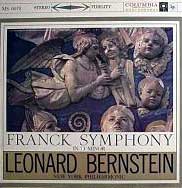 Harvey Grace similarly notes that the return seems dropped in rather than woven or suggested. Yet, Franck clearly was onto something powerful, as the concept of bringing back prior themes has become so commonplace in modern composition as to now seem trite rather than inventive. Harvey Grace similarly notes that the return seems dropped in rather than woven or suggested. Yet, Franck clearly was onto something powerful, as the concept of bringing back prior themes has become so commonplace in modern composition as to now seem trite rather than inventive.
Like his other work, the Symphony at first was a failure. After its completion on August 22, 1888, Franck wanted it included in the famous Lamoureux concert series, but the conductor refused, recalling the failure of Franck's earlier tone poem Les Éolides. Perhaps as a dutiful gesture to one of its own, the Conservatoire grudgingly gave the premiere on February 17, 1889, but only upon the insistence of its conductor, Jules Garcin, who had to overcome not only the orchestra's resistance but the opposition of Franck's fellow professors, one of whom contemptuously dismissed the Symphony outright for daring to feature the cor anglais, which he felt had no legitimate place in a traditional symphony. (As a reader kindly pointed out, Haydn had already used the English horn – indeed two of them – in lieu of the usual oboes in his 1764 Symphony # 22 ("The Philosopher").) Not surprisingly, the performance reportedly was poor.
Critical reaction was divided along the fault line of Franck's reputation. D'Indy found it majestic, plastic, perfectly beautiful, a continual ascent toward pure gladness and life-giving light. Bager since has hailed it as a marvel of logic and cohesion. In his treatise on orchestration, Henry Carse salutes Franck's brilliant orchestration that melds German richness and full tonal volume with characteristic French coloring and distinctive grouping of instrumental voices. Carse cites in particular Franck's assignment of each melodic line to distinctive instrumental groupings,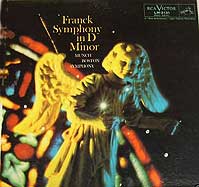 his pioneering use of brass to balance the tone with short melodic chords rather than sustained harmony, and his sensitive doubling in unison or octaves to craft excellent balance and to intensify the texture. his pioneering use of brass to balance the tone with short melodic chords rather than sustained harmony, and his sensitive doubling in unison or octaves to craft excellent balance and to intensify the texture.
Yet, Maurice Ravel, surely among the greatest of all orchestrators, found the Symphony colorless, with heavy instrumentation often spoiling the beauty of its ideas. Others have faulted it for overloaded orchestration, plodding bass, unimaginative wind and brass doubling, weak thematic contrast, lack of organic growth, cloying sweetness, dull passages, senseless repetition, overactive chromaticism, and pointless modulation. Indeed, Ambrose Thomas, a composition professor at the Conservatoire, wondered why Franck called his work a symphony in d minor, since it spent so little time in that key – by his count, within the first fifty bars alone the melody passed from d minor through D-flat, C-flat, f# minor, b-flat minor, c minor, E-flat and f minor. (Franck hardly would have disputed the point, as he constantly urged his organ students to modulate.) In retrospect, Manduell felt that the heart of the matter was a widespread perception of its emotional strength but structural weakness. Even aside from artistic concerns, Franck's wife deplored the Symphony on moral grounds, as she felt that its sensuality and emotion had no place in music.
Perhaps the only way to reconcile these views, all valid, is to step back from technical analysis and aesthetic politics into the realm of the Symphony's irresistible sincerity and sheer humanism. Thus, Bager: "Whatever its faults, it is the work of a supreme artist intent on absolute truth in revealing himself and his faith through an expressive medium. … All his doubts and yearnings came forth. 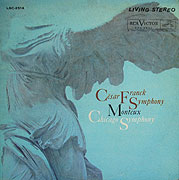 Compassion and comfort softened his pleas. Triumph and rejoicing rang from above … . In shaping his rapture, technic and form merged and dissolved. The result was pure vision in terms of music. In the last analysis, art becomes as irrelevant to the artist as religion to the saint." In any event, the Franck Symphony has become hugely popular. While Harold Schonberg suggests that Franck's mysticism is at odds with our modern scientific outlook, Lang submits that its underlying faith in the midst of uncertainty remains compellingly attractive in our times. Compassion and comfort softened his pleas. Triumph and rejoicing rang from above … . In shaping his rapture, technic and form merged and dissolved. The result was pure vision in terms of music. In the last analysis, art becomes as irrelevant to the artist as religion to the saint." In any event, the Franck Symphony has become hugely popular. While Harold Schonberg suggests that Franck's mysticism is at odds with our modern scientific outlook, Lang submits that its underlying faith in the midst of uncertainty remains compellingly attractive in our times.
In keeping with his detached personality, Franck himself stayed above the fray. According to d'Indy, after Franck returned home from the disastrous premiere, his family gingerly asked if he was pleased and he said, with a beaming countenance, "It sounded well – just as I thought it would!"
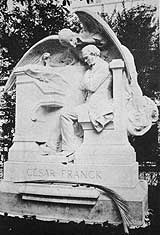
The Franck Monument |
Had Franck not died the next year, it is unclear where his music might have led. After the unusual success of his Quintet performance, he reportedly felt that the public at last was beginning to understand him. As for the Symphony, he said: "I have been very daring, I know; but you wait until next time. I shall go much further in daring there." But we will never know what he had in mind – he wrote no more orchestral music before his death from a freak accident – while absent-mindedly on his way to give a lesson he was struck by a horse-drawn carriage.
The next year, the professors of the Conservatoire snubbed his funeral, and only in 1904 was a monument dedicated at a site opposite the basilica to which he had devoted his professional life. In a moving tribute at the unveiling, M. Henry Marcel, Director of Beaux-Arts, said: "Now he is in his own place, among the choir of immortal geniuses who will be our guides through the future ages, and who constitute, perhaps, the reasons of our existence and the justification of humanity in this world." Marcel's words proved prescient. In retrospect, Lang notes: "Franck's activity not only gave French music new vitality but largely determined its future course" – it fostered an appreciation of instrumental music when most French composers were fixated on opera. (In fairness, though, while his earlier work may have paved the way, Franck's Symphony in d was part of a sudden explosion of French interest in the genre, which produced Lalo's Symphony in g, Saint-Saëns' "Organ" Symphony and d'Indy's Symphony on a French Mountain Air, all completed in 1886, and Chausson's Symphony in B-Flat, which immediately followed in 1889.)
 Ironically, the huge popularity of the Symphony in d was launched by a performance in November 1893 by the same Lamoureux orchestra that had snubbed the premiere. Ironically, the huge popularity of the Symphony in d was launched by a performance in November 1893 by the same Lamoureux orchestra that had snubbed the premiere. 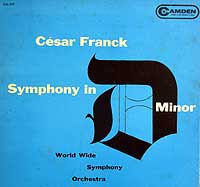 Franck himself never appears to have conducted any of his work, nor, in keeping with his completely uncritical view of even dreadful performances, did he ever signal how he expected others to approach the Symphony. The only indication we have is the score itself, in which many tempos and dynamics are qualified with molto (very) and phrasings often are marked espressivo (expressively), marcato (emphatically), sostenuto (sustained) and other suggestions of strong delineation and emphasis rather than bland continuity. Thus a fundamental question looms over every performance – Does respect for Franck require emulation of his serene personality and strict adherence to the specific directives of his score, or do these same indications suggest that his music was a vehicle to escape the strictures and routine of his tightly-structured everyday life, demanding that his spirit be conjured and liberated through bold personal touches? Franck himself never appears to have conducted any of his work, nor, in keeping with his completely uncritical view of even dreadful performances, did he ever signal how he expected others to approach the Symphony. The only indication we have is the score itself, in which many tempos and dynamics are qualified with molto (very) and phrasings often are marked espressivo (expressively), marcato (emphatically), sostenuto (sustained) and other suggestions of strong delineation and emphasis rather than bland continuity. Thus a fundamental question looms over every performance – Does respect for Franck require emulation of his serene personality and strict adherence to the specific directives of his score, or do these same indications suggest that his music was a vehicle to escape the strictures and routine of his tightly-structured everyday life, demanding that his spirit be conjured and liberated through bold personal touches?
Most recordings tend to adhere to the former approach of presenting a solid and largely faithful rendition of the written score, often achieving a continuous flow of moderated emotion by attenuating expressive indications in favor of nuance and subtlety. Among them are the following:
- Otto Klemperer, New Philharmonia Orchestra (EMI, 1966, 39 minutes) –
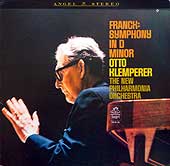 This is somewhat dry but beautifully played, including some dynamic refinement that goes beyond the basic indications of the score, even while seeming well within the spirit of the music. Despite using a full modern complement of players, Klemperer carefully balances his ensemble (and differentiates his second violins by placing them on the right) so as to emphasize the counterpoint that infuses the work with constant fascination. This is somewhat dry but beautifully played, including some dynamic refinement that goes beyond the basic indications of the score, even while seeming well within the spirit of the music. Despite using a full modern complement of players, Klemperer carefully balances his ensemble (and differentiates his second violins by placing them on the right) so as to emphasize the counterpoint that infuses the work with constant fascination.
- Ernest Ansermet, Orchestre de la Suisse Romande (Decca, 1961, 39½') –
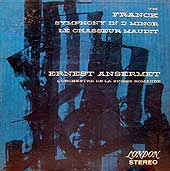 Ansermet pays particular attention to the shifting textures. From the very outset, he underlines the musical progression in the otherwise staid introduction with this approach, which is given added impact through the extraordinarily rich recording of snarling brass, shimmering violins, breathy winds and solid bass, but without self-conscious spotlighting or mixing-board stunts. Yet, after exciting initial power chords, the finale fizzles into a routine rendition that eludes any significant sense of tension and fulfillment, a curious and disappointing contrast to a far more vital Le Chasseur Maudit from the same recording session. Ansermet pays particular attention to the shifting textures. From the very outset, he underlines the musical progression in the otherwise staid introduction with this approach, which is given added impact through the extraordinarily rich recording of snarling brass, shimmering violins, breathy winds and solid bass, but without self-conscious spotlighting or mixing-board stunts. Yet, after exciting initial power chords, the finale fizzles into a routine rendition that eludes any significant sense of tension and fulfillment, a curious and disappointing contrast to a far more vital Le Chasseur Maudit from the same recording session.
- Sir Thomas Beecham, L'Orchestre National de l'ORTF (EMI, 1959, 38½') –
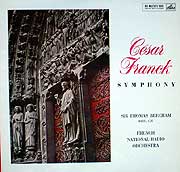 From his final recording sessions, this performance holds a special affection for Sir Thomas's legions of fans, but no biographical allowance is needed to esteem it. A magnificently clear recording reveals luminous textures, exquisite control and organic cohesion in which all the elements pulse with immediacy and work together with a patient, natural air. Sharp and vibrant, Beecham crafts a subtle ebb and flow yet with strongly differentiated tempos from the very outset, in which he delineates the introduction into a kaleidoscope of subtly varied moods and then pauses before plunging into the allegro. No mellow French brass here – the horns tear through the string fabric and the winds hold their own. Sheer magic! An earlier 1940 recording with Beecham's own London Philharmonic (Pearl CD) is surprisingly light, graceful and superbly balanced for its time but despite faster tempos lacks the sense of drive and atmosphere of the remake. From his final recording sessions, this performance holds a special affection for Sir Thomas's legions of fans, but no biographical allowance is needed to esteem it. A magnificently clear recording reveals luminous textures, exquisite control and organic cohesion in which all the elements pulse with immediacy and work together with a patient, natural air. Sharp and vibrant, Beecham crafts a subtle ebb and flow yet with strongly differentiated tempos from the very outset, in which he delineates the introduction into a kaleidoscope of subtly varied moods and then pauses before plunging into the allegro. No mellow French brass here – the horns tear through the string fabric and the winds hold their own. Sheer magic! An earlier 1940 recording with Beecham's own London Philharmonic (Pearl CD) is surprisingly light, graceful and superbly balanced for its time but despite faster tempos lacks the sense of drive and atmosphere of the remake.
- Carlo Maria Giulini, Philharmonia Orchestra (1957, EMI, 40') –
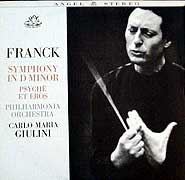 Giulini, too, projects a wonderfully natural aura, but with a considerably wider scope of expression. Although known for precision and detail, his interpretive arsenal ranged from conjuring fearsome orchestral climaxes (Britten's Four Sea Interludes from Peter Grimes) to maintaining long stretches of severely attenuated control (Beethoven's Eroica). Reportedly, Giulini often conducted with his eyes closed, but unlike von Karajan's nominally similar approach, the result didn't seem over-refined or egotistical but rather emerged as if he were internalizing the emotional content and portraying its architecture. Here, his first movement openly flaunts tempo fluctuation, the second basks in a warm opulent glow, and the third melds its elements unaffectedly. Indeed, the entire performance unfolds inexorably, suffused throughout with a spirituality radiating from within. As conductor Simon Rattle observed, Giulini combines elasticity with a tremendous overall discipline. As evidenced by this recording, that's an ideal approach for Franck. Giulini, too, projects a wonderfully natural aura, but with a considerably wider scope of expression. Although known for precision and detail, his interpretive arsenal ranged from conjuring fearsome orchestral climaxes (Britten's Four Sea Interludes from Peter Grimes) to maintaining long stretches of severely attenuated control (Beethoven's Eroica). Reportedly, Giulini often conducted with his eyes closed, but unlike von Karajan's nominally similar approach, the result didn't seem over-refined or egotistical but rather emerged as if he were internalizing the emotional content and portraying its architecture. Here, his first movement openly flaunts tempo fluctuation, the second basks in a warm opulent glow, and the third melds its elements unaffectedly. Indeed, the entire performance unfolds inexorably, suffused throughout with a spirituality radiating from within. As conductor Simon Rattle observed, Giulini combines elasticity with a tremendous overall discipline. As evidenced by this recording, that's an ideal approach for Franck.
- Edouard van Remoortel, Pro Musica Symphony, Vienna (1957, Vox, 43') –
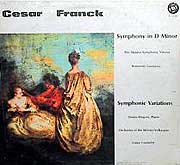 Franck's score has no metronomic specifications of tempo. Rather, the movements bear only abstract suggestions of lento (slow), allegretto (rather lively) and allegro non troppo (not too fast). Yet, the Breitkopf & Härtel version gives a total performance time of 37 minutes, only somewhat faster than the norm on record. Often overlooked, this LP ushered in an era of recordings that dared to distend tempos to explore the serious side of the Symphony. Hardly a household name and relegated to middling orchestras and budget labels, Remoortel's reading is weighted down with pervasive sadness and never fully erupts into joy or affirmation, thus suggesting the inner psyche of the composer, who may have seemed satisfied on the surface but perhaps seethed with repressed frustration. Despite mediocre playing, the concept emerges rather effectively and paved the way for others to follow. Franck's score has no metronomic specifications of tempo. Rather, the movements bear only abstract suggestions of lento (slow), allegretto (rather lively) and allegro non troppo (not too fast). Yet, the Breitkopf & Härtel version gives a total performance time of 37 minutes, only somewhat faster than the norm on record. Often overlooked, this LP ushered in an era of recordings that dared to distend tempos to explore the serious side of the Symphony. Hardly a household name and relegated to middling orchestras and budget labels, Remoortel's reading is weighted down with pervasive sadness and never fully erupts into joy or affirmation, thus suggesting the inner psyche of the composer, who may have seemed satisfied on the surface but perhaps seethed with repressed frustration. Despite mediocre playing, the concept emerges rather effectively and paved the way for others to follow.
- Ricardo Chailly, Royal Concertgebouw Orchestra (Decca, 1987, 42') –
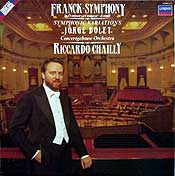 Chailly leads an uninflected performance that combines the best elements of the Klemperer and Ansermet approaches to carefully layer the sound and keep all elements in careful balance with lovely orchestral playing, while adding Remoortel's considerably more deliberate pacing to highlight the shifting modulations. Though much of the inherent drama is lost, it creates effective atmosphere and expectation and perhaps is in keeping with Franck's view of his world from the vantage of a man utterly at peace with himself. The same orchestra had recorded the work with Karel Ancerl in 1969 (Tahra CD) with the same balanced playing, but considerably (six minutes) faster, thus providing a stronger sense of feeling. Chailly leads an uninflected performance that combines the best elements of the Klemperer and Ansermet approaches to carefully layer the sound and keep all elements in careful balance with lovely orchestral playing, while adding Remoortel's considerably more deliberate pacing to highlight the shifting modulations. Though much of the inherent drama is lost, it creates effective atmosphere and expectation and perhaps is in keeping with Franck's view of his world from the vantage of a man utterly at peace with himself. The same orchestra had recorded the work with Karel Ancerl in 1969 (Tahra CD) with the same balanced playing, but considerably (six minutes) faster, thus providing a stronger sense of feeling.
- Lorin Maazel, Berlin Radio Symphony Orchestra (1961, DG, 36') –
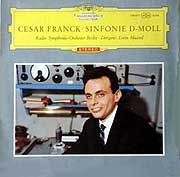 Turning now to the other side of the tempo divide, in one of the very few largely conventional performances to speed by in less than the score's nominal specification of 37 minutes, Maazel complements his fleet tempos with crisp, treble-dominated textures. Yet, his empathetic flexible pacing within his overall plan serves to support and advance the musical structure, adding a level of emotional logic while insisting upon the work's forward-reaching architecture, with no time to wallow in sentiment. The orchestra plays superbly and with a high degree of responsiveness, fueled by prominent tympani that others too often bury in the sonic mass. A 1976 remake with the Cleveland Symphony (Decca, 38') is less distinctive, featuring heavier brass and overall slower tempos. Turning now to the other side of the tempo divide, in one of the very few largely conventional performances to speed by in less than the score's nominal specification of 37 minutes, Maazel complements his fleet tempos with crisp, treble-dominated textures. Yet, his empathetic flexible pacing within his overall plan serves to support and advance the musical structure, adding a level of emotional logic while insisting upon the work's forward-reaching architecture, with no time to wallow in sentiment. The orchestra plays superbly and with a high degree of responsiveness, fueled by prominent tympani that others too often bury in the sonic mass. A 1976 remake with the Cleveland Symphony (Decca, 38') is less distinctive, featuring heavier brass and overall slower tempos.
- Paul Paray, Detroit Symphony (1953 and 1959, Mercury, 34') –
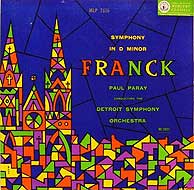 Like Franck, Paray was a French organist, but then he came to America, where he recreated an orchestra to realize his ideal French sound in, of all places, Detroit. His success is abundantly clear in these, as well as so many of his other splendid recordings. Both of his Franck Symphonies are essentially similar, but the mono one is slightly more focused, intense and dark. The album notes declare Paray's intention to "restore to this masterpiece some of its original sinewy strength and clarity of line." Recorded with a single microphone in Detroit's spacious Masonic Temple, Paray goes beyond Maazel to seize upon just the right tempos to move the work inexorably forward through its episodes of fate without unduly rushing its startling climaxes. By the time the finale arrives, Paray adds plastic phrasing that provides expressivity yet avoids overt emotional underlining. Like Franck, Paray was a French organist, but then he came to America, where he recreated an orchestra to realize his ideal French sound in, of all places, Detroit. His success is abundantly clear in these, as well as so many of his other splendid recordings. Both of his Franck Symphonies are essentially similar, but the mono one is slightly more focused, intense and dark. The album notes declare Paray's intention to "restore to this masterpiece some of its original sinewy strength and clarity of line." Recorded with a single microphone in Detroit's spacious Masonic Temple, Paray goes beyond Maazel to seize upon just the right tempos to move the work inexorably forward through its episodes of fate without unduly rushing its startling climaxes. By the time the finale arrives, Paray adds plastic phrasing that provides expressivity yet avoids overt emotional underlining.
- Vladimir Golschmann, St. Louis Symphony (1953, Capitol, 37') –
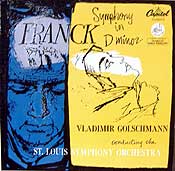 Another lesser known among conductors, Golschmann was born in Paris and delivers a reading of strong climaxes, keen rhythmic acuity and huge romanticized retards that transcends his slight reputation. His second movement is especially effective, as he strongly differentiates its sections so as to emphasize the distinctive character of its two fundamental component elements, thus underlining the unique structure rather than regarding it as a mere transition between the lengthy opening and cyclical finale, as many performances tend to do. Another lesser known among conductors, Golschmann was born in Paris and delivers a reading of strong climaxes, keen rhythmic acuity and huge romanticized retards that transcends his slight reputation. His second movement is especially effective, as he strongly differentiates its sections so as to emphasize the distinctive character of its two fundamental component elements, thus underlining the unique structure rather than regarding it as a mere transition between the lengthy opening and cyclical finale, as many performances tend to do.
- Sir John Barbirolli, Czech Philharmonic (1967, Supraphon CD, 38') –
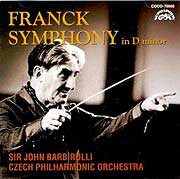 Barbirolli's Symphony in d begins in hushed, patient expectancy, yet never develops the tension of his best Bruckner and Mahler performances. In keeping with the Czech Philharmonic's rich, dark favored sonority, Barbirolli maintains tight control, with careful balances, layered textures and smooth transitions to craft an aural image of cohesion, with structural signposts indicated by slight tempo shifts. Notably, its trademark brass never sting but rather blend into the sonic pile. The only curious touch is an interpolated long pause before the final three chords. Barbirolli's Symphony in d begins in hushed, patient expectancy, yet never develops the tension of his best Bruckner and Mahler performances. In keeping with the Czech Philharmonic's rich, dark favored sonority, Barbirolli maintains tight control, with careful balances, layered textures and smooth transitions to craft an aural image of cohesion, with structural signposts indicated by slight tempo shifts. Notably, its trademark brass never sting but rather blend into the sonic pile. The only curious touch is an interpolated long pause before the final three chords.
- Guido Cantelli, NBC Symphony (1954, RCA, 36') –
 The date of Cantelli's studio recording rings with historical significance, as it was a mere two days after the same orchestra gave the final concert in the astoundingly long and influential career of Arturo Toscanini. Rather than a triumphant celebration of the Maestro's art, he of the perfect memory suffered an unprecedented lapse, numbly beat time during the final selection and before the final chords slunk off the stage a broken man, never again to appear before an audience. With that disquieting event, and all the attendant news reports, still resonating, and perhaps reflecting uncertainty over their own future (indeed they soon would be disbanded), it hardly seems surprising that the NBC gave Cantelli a restrained, precise, brusque performance, perhaps intended to emulate the style of their fallen Maestro, yet drained of enthusiasm. A concert three months earlier (AS Disc, 40½') found the same forces in far better mettle, albeit a full four minutes slower, their attacks more focused and with vastly more tension. The date of Cantelli's studio recording rings with historical significance, as it was a mere two days after the same orchestra gave the final concert in the astoundingly long and influential career of Arturo Toscanini. Rather than a triumphant celebration of the Maestro's art, he of the perfect memory suffered an unprecedented lapse, numbly beat time during the final selection and before the final chords slunk off the stage a broken man, never again to appear before an audience. With that disquieting event, and all the attendant news reports, still resonating, and perhaps reflecting uncertainty over their own future (indeed they soon would be disbanded), it hardly seems surprising that the NBC gave Cantelli a restrained, precise, brusque performance, perhaps intended to emulate the style of their fallen Maestro, yet drained of enthusiasm. A concert three months earlier (AS Disc, 40½') found the same forces in far better mettle, albeit a full four minutes slower, their attacks more focused and with vastly more tension.
- Arturo Toscanini, NBC Symphony (1940 & 1946, RCA, 38') –
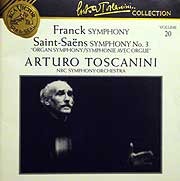 The Maestro himself had approved album release of an amalgam of two broadcasts, substituting a quicker first movement from 1946 into the remaining two from 1940 – a wise choice, as the opener in the earlier concert (available on Music & Arts) tended to drag a bit. The result is a faithful rendition of the score. Although some of the phrasing tends to be clipped, and while Toscanini constantly holds back, he nonetheless arouses some fairly expressive solo playing. Reflecting the aural perspective Toscanini favored (from the vantage of the conductor's stand rather than the audience), the sound is immediate and shorn of ambience, with all choirs and solos fully audible. While largely literal, his reading still manages to generate a fair degree of excitement, thus perhaps proving beyond doubt the excellence of Franck's conception. The Maestro himself had approved album release of an amalgam of two broadcasts, substituting a quicker first movement from 1946 into the remaining two from 1940 – a wise choice, as the opener in the earlier concert (available on Music & Arts) tended to drag a bit. The result is a faithful rendition of the score. Although some of the phrasing tends to be clipped, and while Toscanini constantly holds back, he nonetheless arouses some fairly expressive solo playing. Reflecting the aural perspective Toscanini favored (from the vantage of the conductor's stand rather than the audience), the sound is immediate and shorn of ambience, with all choirs and solos fully audible. While largely literal, his reading still manages to generate a fair degree of excitement, thus perhaps proving beyond doubt the excellence of Franck's conception.
- Eugene Ormandy, Philadelphia Orchestra (1955 and 1961, Columbia, 40') –
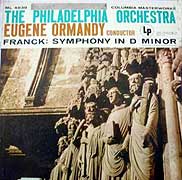 While I try to approach listening to each recording of a favorite work without preconception, I'm afraid that here my judgment is blurred, but I offer no apology. One of my earliest memories of serious music was this very album (the mono version), which my mother's best friend, Roz van Praag, adored and played often when we visited her home. Many of their generation grew up struggling to get by during the Depression, had little time for serious art and looked to music for light distraction from the pressures of everyday life. Yet the Symphony in d – and this recording – somehow resonated deeply with Roz, and she, in turn, seemingly would never tire of telling us how much she enjoyed it. While I try to approach listening to each recording of a favorite work without preconception, I'm afraid that here my judgment is blurred, but I offer no apology. One of my earliest memories of serious music was this very album (the mono version), which my mother's best friend, Roz van Praag, adored and played often when we visited her home. Many of their generation grew up struggling to get by during the Depression, had little time for serious art and looked to music for light distraction from the pressures of everyday life. Yet the Symphony in d – and this recording – somehow resonated deeply with Roz, and she, in turn, seemingly would never tire of telling us how much she enjoyed it. 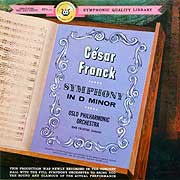 So a dispassionate appraisal is simply impossible. After decades I'd prefer not to count, I got a copy on eBay (mine was the only bid – $2.69 plus postage!), heard it once and must report, after having marvelled at so many others, that it's a rather routine performance – smooth, patient, richly blended, bass-shy, with attenuated climaxes – that leaves much unsaid. I won't hear it again – why spoil my memories, which transcend its actual quality? So a dispassionate appraisal is simply impossible. After decades I'd prefer not to count, I got a copy on eBay (mine was the only bid – $2.69 plus postage!), heard it once and must report, after having marvelled at so many others, that it's a rather routine performance – smooth, patient, richly blended, bass-shy, with attenuated climaxes – that leaves much unsaid. I won't hear it again – why spoil my memories, which transcend its actual quality?
- Oivin Fjeldstad, Oslo Philharmonic (1959, National Academy Record Club, 37') – Last, and perhaps most obscure, but certainly not least,
are two true gems hidden within most unlikely packages, both found in the $1 junk bin at Second Story Books in the DC suburbs. The front cover of the Fjelstad boasts: "This production was newly recorded in the concert hall with the full symphony orchestra to bring you the sound and glamour of the actual performance." The back proclaims: "We guarantee these records are of a physical quality continually comparable to that used in the manufacture of fine long playing records nationally advertised at $3.98 or more each."
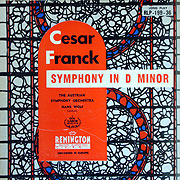 But within lies a strong, vibrant, fleet, fully idiomatic reading played with palpable enthusiasm in sharp, detailed monaural sound ("Recorded, custom processed and pressed by the world's largest record manufacturer" – presumably RCA, judging from the stamper markings) that easily stands on its own without resort to the nonsensical hype inflicted by the marketers. But within lies a strong, vibrant, fleet, fully idiomatic reading played with palpable enthusiasm in sharp, detailed monaural sound ("Recorded, custom processed and pressed by the world's largest record manufacturer" – presumably RCA, judging from the stamper markings) that easily stands on its own without resort to the nonsensical hype inflicted by the marketers.
- Hans Wolf, Austrian Symphony (1950, Remington LP, 36') – Perhaps the least known of all the conductors here, the German-born and -trained Wolf (1912 - 2005) made only a half-dozen recordings, all in 1950 with the Austrian Symphony for the independent American Remington label, after escaping the Nazis and serving in the US Army and before settling into a career based in Seattle. The quality is surprisingly fine, devoting a Stokowskian focus upon textures, as prominent instruments tend to be spotlighted, with the strings lending a chamber-like sound with heavy vibrato when they emerge from the onslaught of surging brass. After an atmospheric opening, tempos tend to be swift, but with a heartfelt central movement and an especially powerful and well-organized finale. Wolf's careful dynamic control is conveyed well by the detailed recording (boasting of "Complete Audible Range Reproduction," possibly emulating Decca/London's famed FFRR [Full Frequency Range Recording] technique).
 Any of the above recordings provides a valid depiction of the score. Yet, especially for those already familiar with the work and perhaps even tiring of it, other performances beckon with special attraction. Any of the above recordings provides a valid depiction of the score. Yet, especially for those already familiar with the work and perhaps even tiring of it, other performances beckon with special attraction.
- Henry Wood, New Queen’s Hall Orchestra (1924, Columbia 78s, 33')
- Piero Coppola, Orchestre Symphonique des Concerts Pasdeloup (1924, 31’)
- Philippe Gaubert, Orchestre de la Societe des Concerts du Conservatoire (1928, Columbia 78s, Andante CD, 39’)
- Albert Wolff, Concerts Lamoureux (1931, Grammophon 78s, 36’)
First, a salute to these pioneering ventures, presumably the very first recordings of the Franck Symphony (although there appears to have been one earlier recording of each movement, possibly cut to fit on a single disc). Despite the severe compromises mandated by the reduced forces, restricted fidelity and cramped atmosphere of the acoustic recording process, Wood managed to craft a highly credible rendition, with an especially propulsive and volatile opening movement that surges with nervous energy, careening amid tense expectation and fleeting relief and brimming throughout with bold inflection. Although quickly forsaken in the rush to electrical recording the following year, Wood’s deeply personal and exciting account remains fascinating and a harbinger of many that would follow. Coppola’s is strikingly similar and, indeed, was completed the very same week in September 1924. Yet, despite lovely lyrical sections and strong dramatic surges, it’s hobbled by some painfully sour playing (possibly aggravated by severe wow in the only transfer I’ve heard) and skewed balances that often submerge the melody in softer passages. Perhaps a more authentic glimpse of the French style of the time can be gleaned from the first electrical sets, both of which are considerably more relaxed, with broader tempos, smoother transitions and somewhat attenuated climaxes, their more architectural focus and mellow aura suggesting more of a langorous dream-state than energized bustle.
- Leopold Stokowski, Philadelphia Orchestra (1935, RCA, 41')
- Leopold Stokowski, Hilversum Radio Philharmonic (1970, London Phase 4, 43')
Stokowski crafts a surprise, although not of the type to be expected from this headstrong individualist. 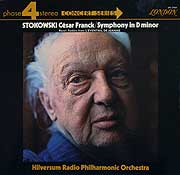 Taking full advantage of the Philadelphia's rich string-heavy blend, the first movement is neither driven nor lingering nor mystical, but rather is played as a thing of pure abstract beauty, and even sounds somewhat impersonal. At 17 minutes, its considerable momentum downshifts to an amazingly leisurely second movement, along with a shift in texture toward the winds, perhaps in salute to their cor anglais member that presents the lovely melody. But all this is in preparation for the duality of the finale, which receives unaccustomed emphasis, combining in its alternating sections the impetus of the first and ease of the second movements. Stokowski smoothly blends these elements drawn from the preceding movements, reflecting not only the variety of life generally, but, by integrating these disparate elements rather than contrasting them, he salutes Franck as a man of faith who fit these aspects of his own being into his work. Stokowski manages to do this naturally and with great musicality, more as a knowing observation than a philosophical imperative. By carefully layering the final chord of the first movement in a progression from strings to brass, Stokowski reminds us that the composer, after all, was an organist. That same background empowers Stokowski's 1970 remake, this time deeply personalized with constant wayward tempo shifts that distend the rhythm, often within single phrases, as if he viewed the entire Symphony as a plan for massive personal improvisation – an approach many will find either fascinating or disconcerting – or, perhaps, both. Taking full advantage of the Philadelphia's rich string-heavy blend, the first movement is neither driven nor lingering nor mystical, but rather is played as a thing of pure abstract beauty, and even sounds somewhat impersonal. At 17 minutes, its considerable momentum downshifts to an amazingly leisurely second movement, along with a shift in texture toward the winds, perhaps in salute to their cor anglais member that presents the lovely melody. But all this is in preparation for the duality of the finale, which receives unaccustomed emphasis, combining in its alternating sections the impetus of the first and ease of the second movements. Stokowski smoothly blends these elements drawn from the preceding movements, reflecting not only the variety of life generally, but, by integrating these disparate elements rather than contrasting them, he salutes Franck as a man of faith who fit these aspects of his own being into his work. Stokowski manages to do this naturally and with great musicality, more as a knowing observation than a philosophical imperative. By carefully layering the final chord of the first movement in a progression from strings to brass, Stokowski reminds us that the composer, after all, was an organist. That same background empowers Stokowski's 1970 remake, this time deeply personalized with constant wayward tempo shifts that distend the rhythm, often within single phrases, as if he viewed the entire Symphony as a plan for massive personal improvisation – an approach many will find either fascinating or disconcerting – or, perhaps, both.
- Willem Mengelberg, Concertgebouw Orchestra of Amsterdam (1940, Telefunken 78s, Biddulph or Telefunken CD, 35')
As with so much of his recorded work, "Mangelberg" uses the Franck score as a mere starting point for an intensely distinctive interpretation. 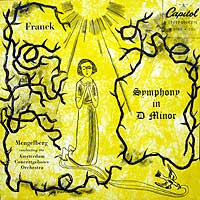 He begins with a brilliant and startling touch. Although it shifts a third higher and adds some wind configurations, the second three minutes of the Symphony are an exact repeat of the first three, even down to accent and dynamic markings, and nearly every other performance follows suit. Not Mengelberg! In his hands, the first iteration emerges with reticence to test the material, gather strength and find inspiration, while the "repeat" is strikingly bolder and assertive, displaying an entirely different character of the same material. Mengelberg even separates the two with an added pause to announce his intention. Far from a quixotic arbitrary quirk, Mengelberg's gesture shows a keen sense of history. Exact repeats of the exposition of a symphonic opening movement in sonata form were standard in the classical and early romantic eras but had gone out of style a half-century before Franck. So why, except for the higher key, should Franck's repetition be played as if it were written by Mozart? With that single brilliant gesture, Mengelberg introduces his conception for the entire work – hugely involving and exciting, with wild extremes of tempos, bridged by exquisitely smooth transitions (even including liberal amounts of old-fashioned portamento [sliding between notes]), and superbly executed by the orchestra to give a full sense of the instrumental fabric. The result delves far beneath the surface to probe Franck's psyche and to find traces of doubt and ecstasy barely suggested by others. Mengelberg's approach does the composer a final favor by preparing us for the last movement. While Stokowski blends its discontinuous sections, Mengelberg emphasizes their differences, yet making them sound like a natural culmination of all the unusual and unexpected gestures that come before. He begins with a brilliant and startling touch. Although it shifts a third higher and adds some wind configurations, the second three minutes of the Symphony are an exact repeat of the first three, even down to accent and dynamic markings, and nearly every other performance follows suit. Not Mengelberg! In his hands, the first iteration emerges with reticence to test the material, gather strength and find inspiration, while the "repeat" is strikingly bolder and assertive, displaying an entirely different character of the same material. Mengelberg even separates the two with an added pause to announce his intention. Far from a quixotic arbitrary quirk, Mengelberg's gesture shows a keen sense of history. Exact repeats of the exposition of a symphonic opening movement in sonata form were standard in the classical and early romantic eras but had gone out of style a half-century before Franck. So why, except for the higher key, should Franck's repetition be played as if it were written by Mozart? With that single brilliant gesture, Mengelberg introduces his conception for the entire work – hugely involving and exciting, with wild extremes of tempos, bridged by exquisitely smooth transitions (even including liberal amounts of old-fashioned portamento [sliding between notes]), and superbly executed by the orchestra to give a full sense of the instrumental fabric. The result delves far beneath the surface to probe Franck's psyche and to find traces of doubt and ecstasy barely suggested by others. Mengelberg's approach does the composer a final favor by preparing us for the last movement. While Stokowski blends its discontinuous sections, Mengelberg emphasizes their differences, yet making them sound like a natural culmination of all the unusual and unexpected gestures that come before.
- Dimitri Mitropoulos, Minneapolis Symphony (1945, Columbia 78s, Lys CD, 38')
- Artur Rodzinsky, New York Philharmonic (live, 1945, AS Disc CD, 37')
I'm treating these performances together because they're two of a kind, and with good reason. 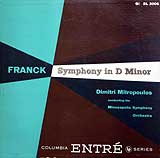 Coming right after the War, they unabashedly explore the full range of emotions inherent in a score that manages to meld elements of deep, collective mourning and rapturous celebration. Like much of Mozart, whose emotions are complex and never absolute, Franck's joy is tinged with sorrow and his grief is infused with hope. And so it is here, as both conductors and their American ensembles unleash a complex threnody of present loss intermingled with a fervent but restless prayer of future hope. Mitropoulos infuses his reading with unbearable intensity and constant discontinuity, not only in the rhythm and phrasing, but even in the gentle pizzicato introduction to the second movement, whose surface calm is challenged and ultimately disrupted by enormously exaggerated volume shifts. His players magnify the sensation of uncertainty through rough articulation, their undercurrent of splintery effort suggesting that attainment of complete inner calm remains elusive in a world recovering from war in which threats of instability remain. So with Rodzinsky, whose NY Philharmonic summons huge reserves of passion. (The mood of his recording, though, is somewhat spoiled by occasional cross-talk in the first movement of the broadcast recording.) Coming right after the War, they unabashedly explore the full range of emotions inherent in a score that manages to meld elements of deep, collective mourning and rapturous celebration. Like much of Mozart, whose emotions are complex and never absolute, Franck's joy is tinged with sorrow and his grief is infused with hope. And so it is here, as both conductors and their American ensembles unleash a complex threnody of present loss intermingled with a fervent but restless prayer of future hope. Mitropoulos infuses his reading with unbearable intensity and constant discontinuity, not only in the rhythm and phrasing, but even in the gentle pizzicato introduction to the second movement, whose surface calm is challenged and ultimately disrupted by enormously exaggerated volume shifts. His players magnify the sensation of uncertainty through rough articulation, their undercurrent of splintery effort suggesting that attainment of complete inner calm remains elusive in a world recovering from war in which threats of instability remain. So with Rodzinsky, whose NY Philharmonic summons huge reserves of passion. (The mood of his recording, though, is somewhat spoiled by occasional cross-talk in the first movement of the broadcast recording.)
- Leonard Bernstein, New York Philharmonic (1959, Columbia LP, 39')
- Leonard Bernstein, Orchestra National de France (1981, DG, 42½')
Bernstein's first recording of the Symphony is youthful yet thoughtful, 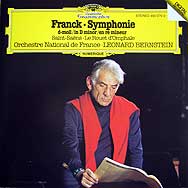 with some impulsive tempo changes at key transition points, although his constant differentiation of the sections of the second movement seems rather schematic. He also tends to temper climaxes and attenuate the brass for a warm, reverberant French sound, even at the cost of an underpowered and unconvincing final climax. His remake, cut live in Paris, extends the French feel with a native orchestra and more closely integrated tempos. Rather than sublimate the former youthful impulse, while taking a far more deliberate pacing Bernstein adds insistent, edgy phrasing for a more deeply heartfelt and expressive reading. Like Mengelberg, Bernstein differentiates the two iterations of the opening, but rather than altering the inflection, he achieves the feat through tempo alone. The ending, though, is as unimposing as in the New York version, as it gallops away from the poised body of the movement and thus seems both incongruous and perfunctory, although perhaps, like the Mitropoulos and Rodzinsky performances, it implies an absence of closure and an uncertain future – a feeling as appropriate to the Cold War era of 1959 and the challenges of 1981 as was in 1945 – and, indeed, today as well. with some impulsive tempo changes at key transition points, although his constant differentiation of the sections of the second movement seems rather schematic. He also tends to temper climaxes and attenuate the brass for a warm, reverberant French sound, even at the cost of an underpowered and unconvincing final climax. His remake, cut live in Paris, extends the French feel with a native orchestra and more closely integrated tempos. Rather than sublimate the former youthful impulse, while taking a far more deliberate pacing Bernstein adds insistent, edgy phrasing for a more deeply heartfelt and expressive reading. Like Mengelberg, Bernstein differentiates the two iterations of the opening, but rather than altering the inflection, he achieves the feat through tempo alone. The ending, though, is as unimposing as in the New York version, as it gallops away from the poised body of the movement and thus seems both incongruous and perfunctory, although perhaps, like the Mitropoulos and Rodzinsky performances, it implies an absence of closure and an uncertain future – a feeling as appropriate to the Cold War era of 1959 and the challenges of 1981 as was in 1945 – and, indeed, today as well.
- Sergiu Celibidache, SDR Symphony (live, 1982, Artists Live CD, 46')
As he often did in his later Munich concert recordings,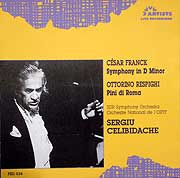 Celibidache pushes the standard repertoire to the limits with extremely slow tempos. Here, the individual movements weigh in at 21:20, 12:10 and 12:20 (compared to "normal" timings of 18, 9½ and 9½ or so). Indeed, his earlier 1962 Celibidache Turin concert (Arkadia CD) unwound at a comparatively swift and conventional 39 minutes. The overall impact is to suggest not so much gravity as a sense of serenity, thus reflecting the composer's outward demeanor (and consistent with Celi's own zen beliefs) and even suggests an occasional affinity with the layered sound of Bruckner, in whose sprawling music Celi reveled. It also tends to shift focus away from overall structure toward atomic components, an approach Celi enhances by carefully shaping not only phrases but individual held notes, which under his baton tend to swell toward the middle of their duration. His second movement is a wisp of whispers and suggestions, while the finale consistently holds back until each outbreak of the "faith" theme, which gain considerable prominence as a result. While not the most suitable choice to become acquainted with Franck's Symphony, Celi's concert provides a unique and fascinating perspective. Celibidache pushes the standard repertoire to the limits with extremely slow tempos. Here, the individual movements weigh in at 21:20, 12:10 and 12:20 (compared to "normal" timings of 18, 9½ and 9½ or so). Indeed, his earlier 1962 Celibidache Turin concert (Arkadia CD) unwound at a comparatively swift and conventional 39 minutes. The overall impact is to suggest not so much gravity as a sense of serenity, thus reflecting the composer's outward demeanor (and consistent with Celi's own zen beliefs) and even suggests an occasional affinity with the layered sound of Bruckner, in whose sprawling music Celi reveled. It also tends to shift focus away from overall structure toward atomic components, an approach Celi enhances by carefully shaping not only phrases but individual held notes, which under his baton tend to swell toward the middle of their duration. His second movement is a wisp of whispers and suggestions, while the finale consistently holds back until each outbreak of the "faith" theme, which gain considerable prominence as a result. While not the most suitable choice to become acquainted with Franck's Symphony, Celi's concert provides a unique and fascinating perspective.
- Charles Munch, Orchestre de la Société des Concerts du Conservatoire (1946, Decca 78s, Lys CD, 34')
- Charles Munch, Boston Symphony (1956, RCA, 36')
- Charles Munch, Orchestre National de France (live, 1967, Valois CD, 32')
In terms of background – born to an organ professor in Alsace (French-speaking but German occupied) – Munch shadowed Franck. 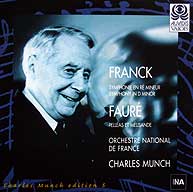 His three recordings of the Symphony share his predilection for light yet exciting readings of heavy German symphonic repertoire. The timing listed for the final concert recording isn't a typo – he really does tear through the entire work in barely 32 minutes, yet this is one of his very few performances that seems to lose more than it gains from sheer velocity. The first movement constantly presses forward but eludes the sense of doubt and contrasted emotion at its core. Like trying to absorb a video on fast forward, too much mood is lost and detail overlooked. Even so, there are sections of relative repose and the overall effect is one of continuity. The second movement works best, fusing its two sections with common drive and considerable grace. (Other symphonies in the same CD set of similar vintage are paced more typically – a 28-minute Schumann Fourth, 46-minute Berlioz Fantastique and 35-minute Beethoven Seventh.) Munch's first recording, with the Conservatoire orchestra, is still uncommonly fleet, but at 34 minutes seems about as fast as the work can tolerate without shortchanging its values, with all the urgency but without the superficial strain. His nearly normal remake with the Boston Symphony boasts strongly differentiated sections, leaping away from repose with gutsy abandon, a sweet but piercing trumpet adding to a French sound, and exceptionally light textures of the second movement contributing to a deceptive sensation of seeming even faster than it really is. Indeed, Munch's overall approach is far more French than German, rejecting suggestions of weight or rumination for a sense of presenting pure music, and thus perhaps reflecting the composer's efforts to remain aloof from the aesthetic battles that surrounded him. His three recordings of the Symphony share his predilection for light yet exciting readings of heavy German symphonic repertoire. The timing listed for the final concert recording isn't a typo – he really does tear through the entire work in barely 32 minutes, yet this is one of his very few performances that seems to lose more than it gains from sheer velocity. The first movement constantly presses forward but eludes the sense of doubt and contrasted emotion at its core. Like trying to absorb a video on fast forward, too much mood is lost and detail overlooked. Even so, there are sections of relative repose and the overall effect is one of continuity. The second movement works best, fusing its two sections with common drive and considerable grace. (Other symphonies in the same CD set of similar vintage are paced more typically – a 28-minute Schumann Fourth, 46-minute Berlioz Fantastique and 35-minute Beethoven Seventh.) Munch's first recording, with the Conservatoire orchestra, is still uncommonly fleet, but at 34 minutes seems about as fast as the work can tolerate without shortchanging its values, with all the urgency but without the superficial strain. His nearly normal remake with the Boston Symphony boasts strongly differentiated sections, leaping away from repose with gutsy abandon, a sweet but piercing trumpet adding to a French sound, and exceptionally light textures of the second movement contributing to a deceptive sensation of seeming even faster than it really is. Indeed, Munch's overall approach is far more French than German, rejecting suggestions of weight or rumination for a sense of presenting pure music, and thus perhaps reflecting the composer's efforts to remain aloof from the aesthetic battles that surrounded him.
- Pierre Monteux, San Francisco Symphony (1941, RCA 78s)
- Pierre Monteux, San Francisco Symphony (1950, RCA LP)
- Pierre Monteux, Chicago Symphony (1961, RCA, 39')
Of all the conductors who have recorded the Franck Symphony, Monteux can claim the closest affinity with the composer – as a student at the Conservatoire beginning in 1885, he may have attended the premiere. 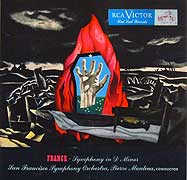 In any event, critics have praised his recordings as definitive. The two San Francisco outings are extremely similar – fleet, sweet and eager, often anticipating downbeats with an emphatic jolt, although the first is slightly less emphatic and suffers from RCA's typically dim fidelity of the time. (To be fair, I'm judging from a curious LP transfer on the budget Camden label, which identifies the orchestra as the "World Wide Symphony" and makes no mention at all of any conductor, presumably to avoid competing with full-priced RCA product.) (A live 1946 San Francisco concert on Music & Arts boasts an extra dollop of kinetic drive and sharper contrasts, especially with a smoldering gathering of strength before the final explosive climax.) His vaunted stereo Chicago remake is somewhat more deliberate but boasts a virtuostic ensemble strutting at the top of its form. My original Living Stereo LP, though, has brash, untamed sonics, cut very loud so as to leave little room for respite, the impact of the climaxes abetted by substantial distortion, as if the grooves literally couldn't contain the full measure of Monteux's excitement. A sonic upgrade was attempted in RCA's short-lived 0.5 Series in 1981. On the cusp of digital recording, and seeking a sonic edge over conventional LPs, several labels toyed with technological tweaks. EMI launched a 45 rpm series, increasing groove velocity while justifying a consequent decrease in playing time (but not retail price). RCA's approach was to operate both master tape playback and lacquer cutters at half-speed in order to find and convey greater detail in the original recordings. Here, the result is a noticeably cleaner and more open sound than even in the CD transfer in RCA's 1994 Monteux Edition (although the climaxes could not entirely escape the compression and distortion of the original). All of Monteux's recordings are surprisingly straight-forward readings of the score. Their excellence provides the ultimate proof that refutes the composer's many critics – Franck knew exactly how to achieve the effects he wanted in order to convey his conception. In any event, critics have praised his recordings as definitive. The two San Francisco outings are extremely similar – fleet, sweet and eager, often anticipating downbeats with an emphatic jolt, although the first is slightly less emphatic and suffers from RCA's typically dim fidelity of the time. (To be fair, I'm judging from a curious LP transfer on the budget Camden label, which identifies the orchestra as the "World Wide Symphony" and makes no mention at all of any conductor, presumably to avoid competing with full-priced RCA product.) (A live 1946 San Francisco concert on Music & Arts boasts an extra dollop of kinetic drive and sharper contrasts, especially with a smoldering gathering of strength before the final explosive climax.) His vaunted stereo Chicago remake is somewhat more deliberate but boasts a virtuostic ensemble strutting at the top of its form. My original Living Stereo LP, though, has brash, untamed sonics, cut very loud so as to leave little room for respite, the impact of the climaxes abetted by substantial distortion, as if the grooves literally couldn't contain the full measure of Monteux's excitement. A sonic upgrade was attempted in RCA's short-lived 0.5 Series in 1981. On the cusp of digital recording, and seeking a sonic edge over conventional LPs, several labels toyed with technological tweaks. EMI launched a 45 rpm series, increasing groove velocity while justifying a consequent decrease in playing time (but not retail price). RCA's approach was to operate both master tape playback and lacquer cutters at half-speed in order to find and convey greater detail in the original recordings. Here, the result is a noticeably cleaner and more open sound than even in the CD transfer in RCA's 1994 Monteux Edition (although the climaxes could not entirely escape the compression and distortion of the original). All of Monteux's recordings are surprisingly straight-forward readings of the score. Their excellence provides the ultimate proof that refutes the composer's many critics – Franck knew exactly how to achieve the effects he wanted in order to convey his conception.
- Wilhelm Furtwängler, Vienna Philharmonic (live, 1945, Recital LP, 40')
- Wilhelm Furtwängler, Vienna Philharmonic (1953, Decca, 40')
And then, when all is said and done, there's Furtwängler. His widely-circulated and readily-available 1953 recording, one of two he made for Decca, is typical of his studio product with the Vienna Philharmonic – rich, smooth, patient, refined, spiritual, beautifully played – and utterly uninspiring. 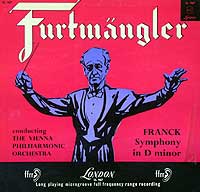 So an earlier concert by the same forces packs quite a surprise. To those familiar with the Furtwängler canon, the date rings with significance – January 29, 1945. Six days earlier, he had given what would turn out to be his final wartime concert with the Berlin Philharmonic, featuring a staggeringly intense Brahms First that fully reflected his conflicted emotions – Furtwängler was keenly aware that the culture to which he had devoted his life was crumbling and that vengeance for his subversive activities was looming. Indeed, after this one last appearance in Vienna he fled to Switzerland, where he would remain in limbo for over two years until the Allied authorities absolved him of collaboration. His farewell to the life he knew was not his famous Beethoven, Brahms or Bruckner, but instead turned out to be the unlikely vehicle of the Franck Symphony, and so it was into that vessel that he poured his tortured soul. If Mitropoulos and Rodzinsky were peering in relief both back and forward at the end of their War, Furtwängler was still fully embroiled in his and could only look ahead to a gaping void. The first movement is not merely gripping but downright terrifying, heaving with grueling emotion, its tempos ranging from standstill to runaway and dynamics from barely audible to overwhelming, fueled by screaming apocalyptic trumpets and thundering tympani. The introduction points the way with a frightening vertiginous acceleration that rips the largo out of its exploratory anchoring torpor and actually has to slow down for the ensuing allegro, now drained of its customary invigorating punch. It's hard to imagine that such demonic intensity arises from the normally staid Vienna Philharmonic, rather than Furtwängler's Berlin Philharmonic, with which he worked similar wartime transformations. Indeed, this performance is most akin to his astounding 1943 Berlin Bruckner Ninth, which utterly ignored the accepted bounds of interpretation to craft a thorough and deeply personal reinvention – the very epitome of Furtwängler's unique art. After the brutal and shocking drama and blistering bombast of the first movement, the second is perversely calm and graceful, yet throbbing with lingering nervous energy as it teeters between steadfast pacing and hints of urgency. The finale, heavily inflected, seals the work with a vision of gloom, its theme not of redemption, joy or triumph but oppressively thick, plodding and grim. Furtwängler's utter transformation of the Franck Symphony should only be heard by those who know the work well and who thus can appreciate the daring and magnitude of his astounding achievement. So an earlier concert by the same forces packs quite a surprise. To those familiar with the Furtwängler canon, the date rings with significance – January 29, 1945. Six days earlier, he had given what would turn out to be his final wartime concert with the Berlin Philharmonic, featuring a staggeringly intense Brahms First that fully reflected his conflicted emotions – Furtwängler was keenly aware that the culture to which he had devoted his life was crumbling and that vengeance for his subversive activities was looming. Indeed, after this one last appearance in Vienna he fled to Switzerland, where he would remain in limbo for over two years until the Allied authorities absolved him of collaboration. His farewell to the life he knew was not his famous Beethoven, Brahms or Bruckner, but instead turned out to be the unlikely vehicle of the Franck Symphony, and so it was into that vessel that he poured his tortured soul. If Mitropoulos and Rodzinsky were peering in relief both back and forward at the end of their War, Furtwängler was still fully embroiled in his and could only look ahead to a gaping void. The first movement is not merely gripping but downright terrifying, heaving with grueling emotion, its tempos ranging from standstill to runaway and dynamics from barely audible to overwhelming, fueled by screaming apocalyptic trumpets and thundering tympani. The introduction points the way with a frightening vertiginous acceleration that rips the largo out of its exploratory anchoring torpor and actually has to slow down for the ensuing allegro, now drained of its customary invigorating punch. It's hard to imagine that such demonic intensity arises from the normally staid Vienna Philharmonic, rather than Furtwängler's Berlin Philharmonic, with which he worked similar wartime transformations. Indeed, this performance is most akin to his astounding 1943 Berlin Bruckner Ninth, which utterly ignored the accepted bounds of interpretation to craft a thorough and deeply personal reinvention – the very epitome of Furtwängler's unique art. After the brutal and shocking drama and blistering bombast of the first movement, the second is perversely calm and graceful, yet throbbing with lingering nervous energy as it teeters between steadfast pacing and hints of urgency. The finale, heavily inflected, seals the work with a vision of gloom, its theme not of redemption, joy or triumph but oppressively thick, plodding and grim. Furtwängler's utter transformation of the Franck Symphony should only be heard by those who know the work well and who thus can appreciate the daring and magnitude of his astounding achievement.
 The seminal book about Franck is the first account of his life and work by his student, disciple and fellow composer Vincent d'Indy: César Franck (Tr: Rosa Newmarch, John Lane, 1910). While d'Indy presents many details and contemporaneous observations, his book is often dismissed as more hagiography than biography. Thus Leon Vallas calls d'Indy's book a "pretty legend," a work of devotion in which his pupils crafted a distorted history to justify their love and admiration of their master. Vallas's own fine biography, César Franck (Tr: Hubert Foss, Oxford University, 1951), paints a more balanced picture, acknowledging faults alongside the many splendors. Secondary sources with valuable insights include John Manduell's article on Franck in The Symphony (Penguin, 1966), James Lyon's notes to the Paray/Detroit mono LP (Mercury MG-50023, 1953), the entry by Harvey Grace in the 1954 edition of Grove's Dictionary of Music and Musicians, Peter Jost's introduction to the Breitkopf & Härtel score, and the relevant portions of Harold Schoenberg's Lives of the Great Composers (Norton, 1970), Henry Carse's History of Orchestration (Keyen Paul, 1935), Milton Cross's Great Composers and Their Music (Doubleday, 1953), Roger Bager's Concert Companion (Whittlesey House, 1947) and Paul Henry Lang's Music in Western Civilization (Norton, 1941). The seminal book about Franck is the first account of his life and work by his student, disciple and fellow composer Vincent d'Indy: César Franck (Tr: Rosa Newmarch, John Lane, 1910). While d'Indy presents many details and contemporaneous observations, his book is often dismissed as more hagiography than biography. Thus Leon Vallas calls d'Indy's book a "pretty legend," a work of devotion in which his pupils crafted a distorted history to justify their love and admiration of their master. Vallas's own fine biography, César Franck (Tr: Hubert Foss, Oxford University, 1951), paints a more balanced picture, acknowledging faults alongside the many splendors. Secondary sources with valuable insights include John Manduell's article on Franck in The Symphony (Penguin, 1966), James Lyon's notes to the Paray/Detroit mono LP (Mercury MG-50023, 1953), the entry by Harvey Grace in the 1954 edition of Grove's Dictionary of Music and Musicians, Peter Jost's introduction to the Breitkopf & Härtel score, and the relevant portions of Harold Schoenberg's Lives of the Great Composers (Norton, 1970), Henry Carse's History of Orchestration (Keyen Paul, 1935), Milton Cross's Great Composers and Their Music (Doubleday, 1953), Roger Bager's Concert Companion (Whittlesey House, 1947) and Paul Henry Lang's Music in Western Civilization (Norton, 1941).

Copyright 2010 by Peter Gutmann
|

 Harvey Grace similarly notes that the return seems dropped in rather than woven or suggested. Yet, Franck clearly was onto something powerful, as the concept of bringing back prior themes has become so commonplace in modern composition as to now seem trite rather than inventive.
Harvey Grace similarly notes that the return seems dropped in rather than woven or suggested. Yet, Franck clearly was onto something powerful, as the concept of bringing back prior themes has become so commonplace in modern composition as to now seem trite rather than inventive.